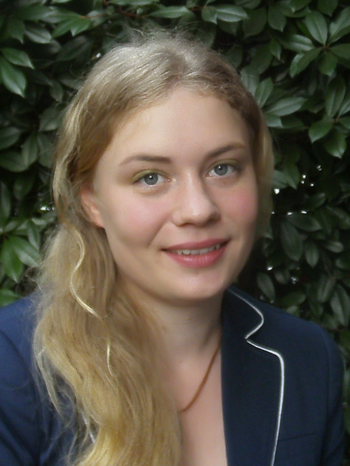Dr. Elisabeth Günther

Ancient Languages and Texts (ALT)
Classical Archaeology
Fachbereich Klassische Archäologie
91054 Erlangen
11/2014 - 2018
Promotionsstipendiatin in der Forschergruppe C-1 des Exzellenzclusters Topoi, Promotion am Institut für Klassische Archäologie der Freien Universität Berlin bei Frau Prof. Dr. J. Fabricius
2014
Abschluss des Magisterstudiums: Klassische Archäologie, Klassische Philologie und Biologie an der Johannes Gutenberg-Universität Mainz
2013 – 2014
Studentische Hilfskraft bei der Akademie der Wissenschaften Mainz und an der Universität Trier im Projekt "Forschungen zur antiken Sklaverei" (Leitung: Dr. J. Deißler)
07/2013
Vortrag in der Römerhalle Bad Kreuznach: "Von Gattinnen und Göttinnen – Die 'First Ladies' der Römischen Kaiserzeit" in der Vortragsreihe "Starke Frauen" des Frauenhauses Bad Kreuznach e.V.
07 – 08/2012
Grabungspraktikum in Patara (Türkei) (Leitung: Dr. M. Kočak / Dr. K. Mahler, Johannes Gutenberg-Universität, Mainz), gefördert durch das PROMOS-Stipendium des DAAD
03 – 04/2012
Museumspraktikum am Jordan Museum Amman (Jordanien) (Leitung: Dr. Kairieh Amr)
04/2011
Teilnahme an der Frühjahrsakademie "Macht und Religion" des ZaKMiRa der Universität Köln
07 – 08/2010
Praktikum in Stratos/Palairos zur Keramikaufarbeitung mit dem Institut für Klassische Archäologie der TU Darmstadt (Leitung: Frau Prof. Dr. F. Lang)
03/2010
Teilnahme am Darmstädter Traineeprogramm Keramik der TU Darmstadt (Leitung: Frau Prof. Dr. F. Lang)
2010/2011
Studentische Hilfskraft am Institut für Klassische Archäologie, Mainz, Tutoriumsleitung
Comical Space. Communication and Interaction on Vases from Southern Italy
This Ph.D. project offers a new, detailed analysis of the iconography of the so-called “phlyax”-vases from the 4th century BC. Due to an emphasis on pictorial elements of interaction and communication within the images – especially gesture and body language – the project moved away from static typologies of masks or role-types to an image-specific construction of human interactions and social hierarchies.
In addition, it enriches the mainly theatre-historical approach of current research with an iconographical perspective on comedy-related vase-paintings: the chronological development of pictorial elements, the combinations and connection between such elements as well as the conception of space within the images can be traced back to the stylistic and workshop-specific iconographic conventions in the 4th century BC.
First results
Within Topoi research group (C-1) Deixis and Frames of Reference, this fundamental analysis of comedy-related vases gives way to a new interpretation of the images on the semantic level of pictorial elements. Both, the pictorial elements and their spatial relation within the image contain information for the viewer/recipient: they activate frames of knowledge that the viewer has gained through experience, e.g. daily life, literature, cultural behaviour, other vase-paintings and/or visual media, theatre performances and so on. Erving Goffman and Dietrich Busse already described such frames in social sciences and linguistics, making this approach highly valuable for and applicable to the analysis of visual media. Using a modified frame-theory adapted to archaeological sources and methodology, the Ph.D. thesis shows that the interpretation of comedy-related vase-paintings is not only restricted to comedy plots, but that the images rather activate different, sometimes incongruent, frames to evoke a comic narrative, depending on different levels of perception by the viewers.
This stimulates further questions regarding the historical background of these, and other, vases. Thus, the frame-theory offers a broader view on the culture(s) in South-Italy and Sicily and is not restricted to a Greek-Italian dualism; rather it favours a differentiation of the cultural background of regions, cities and groups within a specific society. In addition, the dependence of pictorial elements on workshops and styles and their development shed light on the economic sphere and trade between the different regions of South-Italy and Sicily.
This dissertation project was successfully completed within the Research Group C-1 Deixis and frames of reference: Strategies of perspectivation in language, text, and imageof the Excellence Cluster 264 Topoi.
2015
(im Druck)
Rezension zu: Erfahrungsfeld Schule und Archäologie, Hrsg. vom Pädagogischen Landesinstitut Rheinland-Pfalz, Bad Kreuznach: Pädagogisches Landesinstitut, 2012 (PL-Information 4/2012), Alzeyer Geschichtsblätter 41.
(im Druck)
Rezension zu: LVR-LandesMuseum Bonn, Archäologisches Landesmuseum Baden-Württemberg und Museum Het Valkhof Nijmegen (Hrsg.), Gebrochener Glanz. Römische Großbronzen am UNESCO-Welterbe Limes. Begleitbuch zur Ausstellung des LVR-LandesMuseum Bonn, des Archäologischen Landesmuseums Baden-Württemberg und des Museums Het Valkhof Nijmegen, Mainz: Nünnerich-Asmus Verlag & Media, 2014, Alzeyer Geschichtsblätter.
2013
Rezension zu: H. Hinkel (Hrsg.), Bibliotheca S. Martini Moguntina. Alte Bücher – Neue Funde, Alzeyer Geschichtsblätter 40, 225-227.
2012
F. Weise, E. Löser, "Medium der Macht: Die 'First Ladies' des Imperium Romanum im Münzbild, MünzenRevue". International coin trend journal, 9/2012, 136-141.
2009
S. Günther, M. Pahlke (ed.), Alkuin. Propositiones ad acuendos iuvenes / Aufgaben zur Schärfung des Geistes der Jugend (Lindauers Lateinische Lektüren), München 2009. (Illustrationen und Layout)
2007
"Waschen ohne Reue?", in: Die Waschnuss in der Minikläranlage, Junge Wissenschaft / Young Researcher. Jugend forscht in Natur und Technik 82, 24. Jahrgang 2009, 27—33. (Publikation im Rahmen der Jugend forscht-Arbeit "Untersuchung der biologischen Abbaubarkeit von Waschnusstensiden mit einer standardisierten Modellkläranlage", Teilnahme am Bundeswettbewerb im Schuljahr 2007)
